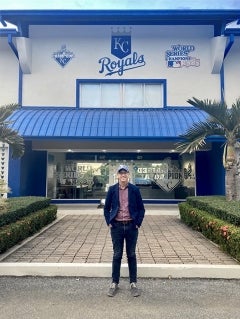ASU professor examines multilingualism in baseball

Associate Professor Brendan O’Connor's professional background as a linguistic anthropologist and avid baseball fan sparked the idea to dive deeper into multilingualism in baseball. Photo courtesy: Brendan O'Connor
America’s pastime has grown significantly since its inception in the 1830s and now can be found worldwide, with players from more than 20 countries playing in U.S. professional baseball.
At the beginning of the 2022 Major League Baseball season, there were 275 international players on Opening Day rosters, the second most in league history.
With the game's growth, diverse cultures and languages have intertwined into the sport.
“Multilingual Baseball: Language Learning, Identity, and Intercultural Communication in the Transnational Game,” by School of Transborder Studies Assistant Professor Brendan O’Connor, is the first book-length study on language diversity in professional sports.
“It’s a big-picture view of language in professional baseball. It starts with a historical perspective on the presence of players from different racial and ethnic backgrounds and also speakers of different languages dating back to the beginning of baseball in the U.S.,” O’Connor said.
O’Connor’s professional background as a linguistic anthropologist and avid baseball fan sparked the idea to dive deeper into multilingualism in baseball.
“I’ve done a lot of work with bilingual students and families, mostly in the U.S.-Mexico borderlands in Arizona and Texas looking at language learning and identity and communication,” O’Connor said. “I’m a huge baseball fan and wrote a short article about the topic. It got the attention of other media and some professional teams asking for more research on this.”
Research for the book, funded by ASU’s Global Sports Institute Seed Grant, included firsthand observations in baseball environments in the U.S. and the Dominican Republic, and interviews with current and former players, coaches, front office personnel, international scouts, language teachers and interpreters with baseball experience in the Dominican Republic, Cuba, South Korea, Taiwan and the U.S.

Brendan O'Connor
The book shows the daily interactions with linguistic and cultural differences on the field, in the clubhouse and in communities worldwide by delving into “social issues in diverse societies by connecting interactions with baseball to broader challenges” and invites the reader “to consider what we can learn from the bilingual understandings that arise in everyday baseball interactions,” according to the book’s description.
O’Connor hopes his book can help bridge a gap between people’s identities and cultures and create a shared understanding.
“American baseball, in many ways, is a microcosm of the U.S. itself,” he said. “It’s this fishbowl where we can see all of these conversations and tensions around demographic change, immigration and multilingualism playing out in a way that is, on the one hand, unique to baseball but, on the other hand, has a lot in common with these bigger discussions.”
“How can observing those dynamics in baseball and seeing it play out on a baseball diamond help us to understand a little bit better what’s happening in society at large?”
More Arts, humanities and education

Professor's acoustic research repurposed into relaxing listening sessions for all
Garth Paine, an expert in acoustic ecology, has spent years traveling the world to collect specialized audio recordings.He’s been…

Filmmaker Spike Lee’s storytelling skills captivate audience at ASU event
Legendary filmmaker Spike Lee was this year’s distinguished speaker for the Delivering Democracy 2025 dialogue — a free…

Grammy-winning producer Timbaland to headline ASU music industry conference
The Arizona State University Popular Music program’s Music Industry Career Conference is set to provide students with exposure to…

